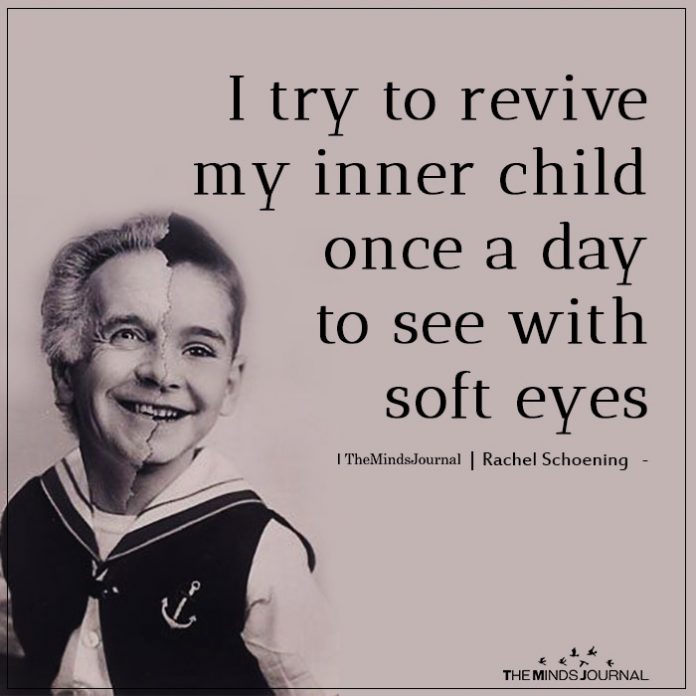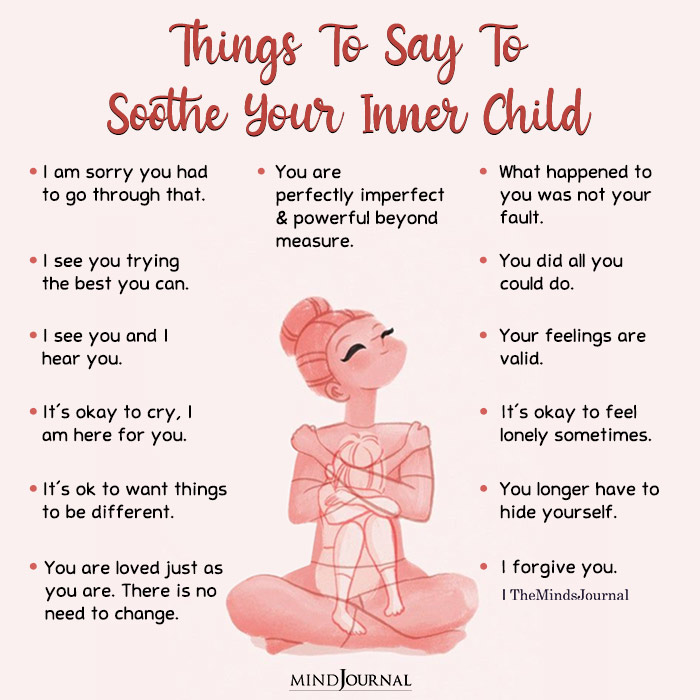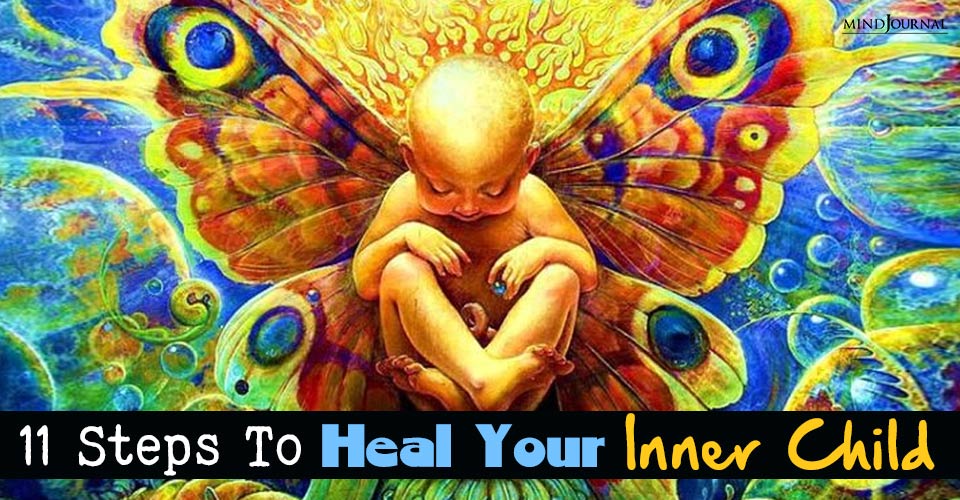Healing your inner child is a journey toward self-discovery and self-love. Acknowledge and nurture the emotional wounds of your past, with the steps below!
We all have an “inner child,” which is an unconscious archetype coined by Carl Jung. It holds our vulnerability, spontaneity, creativity, curiosity, and magical ideas. It also holds fears, anxiety, shame, loneliness, trauma, and insecurity experienced growing up.
Our inner child manifests through our beliefs and actions and can have a negative influence on our thoughts, feelings, interpersonal behavior, and choices as adults. To heal, we must develop a relationship with our wounded self.
Trauma and Our Inner Child
Trauma that happens in childhood lives in the body. Unhealed emotions and trauma reactions that were unsafe for our younger self to feel or express are stored in our memory and tissues.
It is our inner child that remembers and is haunted by old hurts and fears. It clings to beliefs that helped us survive in a dysfunctional family. Parts of ourselves can get stuck at an earlier age and inhibit the expression of our authentic, true self.

Befriending and communicating with our child self is one avenue of healing trauma. It also develops self-love and frees our true self.
To protect ourselves from pain and to function in the present, we may be unaware of our inner child’s feelings – both from the past and in the present. We might not realize we feel hurt, afraid, angry, or that we feel unlovable. But denial and hiding our pain doesn’t help us in the long run.
Related: How Reconnecting With My Inner Child Changed My Life
Running from our suffering prolongs it. Pain eventually shows up as anxiety, self-sabotage, irritability, illness, or physical pain. Other clues that your inner child is present are when you feel immature, insecure, alienated, inferior, or younger than your peers and colleagues.
It can also be disguised as withdrawal, enabling, depression, addiction, raging, compulsive people-pleasing, passive-aggression, or fear of confrontation or abandonment. In fact, nearly all codependent symptoms stem from childhood trauma and shame.
Steps To Healing Your Inner Child
The goal of healing our inner child is to validate our inner child’s feelings and needs and give it the love, support, and protection we didn’t receive in the past.

Make time to connect with your inner child daily and especially when you feel anxious, lonely, afraid, disappointed, or depressed or have a strong reaction to an interpersonal situation. This is often a sign that a childhood wound is being triggered.
- The first step is acknowledging your feelings. You don’t have to identify your “inner child,” but it can be helpful to think of the part of you that feels insecure as younger and in need of your love and protection.
- Look at pictures of your childhood self to help you visualize your inner child.
- Conjure up memories of your childhood school, home, and your room. Use all your senses to recall smells, sounds, sights, and feelings. Listen for voices of the adults in your world. Did you feel safe? What or who gave you comfort?
- Whenever you contact your inner child, never scold or say “should.” Instead:
- Ask permission. Your inner child may be afraid and not trust you. So ask if you may talk to him or her and whether you may sit beside or hug your inner child.
- Find out what your inner child feels about past events, your home life, family members, and people in your adult life.
- Validate your inner child’s feelings and support its experiences. Do not judge them or rationalize, justify, or minimize the behavior of others.
Use words, such as, “I understand.” “I hear you.” “I love you.” It’s okay.” “You’re not alone. I’ll never leave you.” “I support you and will protect you.” “You’re innocent.” “I care about you.” “You’re fun and lovable.”

- Ask what your child needs from you – specifically. If your child needs love, find out what actions would feel loving. If your child wants to play, find out what would be fun.
- Comfort your child with loving words, empathy, and with soothing touch or an embrace.
- Protect your child. Visualize protecting your child in the past. (See No. 5, below.) Find out what would make your child feel safe in the present.
- Thank your inner child for its vulnerability, courage, and strength. After all, despite the losses and trauma you did survive with whatever coping skills you had at a young age.
Related The Inner Child Who Needed Healing
- If you’re triggered by a present event, allow your feelings to connect you to an earlier time when you felt similarly. Watch the scene unfold. Talk to and comfort your inner child as stated above.
Protect your child by imagining the adult you (or another trusted advocate) standing up to abuse and setting firm boundaries. Later, write what you felt, impressions, beliefs, and decisions that you formed as a result of the past and your visualized scene. - Dialogue on paper or in your imagination with your inner child, and gather the information described in No. 4, above. If writing, use your dominant hand to journal as the adult and your non-dominant hand to voice your inner child.
Your non-dominant hand channels your right, emotional and intuitive brain. Take time to be patient, empathetic, and loving with your responses. Never judge. Do this daily to build a strong relationship with your neglected inner child. Doing so integrates two sides of yourself and builds self-love and self-nurturing skills. - Do the above exercise in front of a mirror, and speak as a loving parent directly to your own reflection. Say the words your child longed to hear then and wants to hear today. You can use phrases from the Self-Love Meditation.
- Journal as your inner child at different ages about different events and family dynamics. How did the toddler feel, your school-age and adolescent selves?
- Write letters from your inner child to family and friends who have caused you pain. Allow full expression of your raw feelings. These letters should be uninhibited, unedited, and unsent.
- Connect with your playful inner child. Recall activities and hobbies from childhood, and make time for fun. If you don’t recall any, find out through dialoguing and create play dates. Try something new, and allow yourself to be frivolous, make mistakes, and act silly.
- Use creativity to channel and delight your inner child. Find the right medium for you, such as cooking, art, crafts, music, dance, poetry, cooking, and singing. Tell your inner critic to take a hike, and allow yourself the freedom to express your imagination.
For example, you needn’t be a skilled artist to paint your emotions, to color in a coloring book, paint seashells, or to make a collage of leaves and found items. Your inner child speaks through movement, vibrations, and imagery. When you dance or move, forget about doing steps, but move to music and your emotions. You will feel a mind-body
Healing our inner child is an ongoing practice that takes time. It necessitates creating a safe, quiet place for you to engage in the process. Change begins within. Making that commitment validates your worth.
Self-parenting helps you regulate your emotions and strengthen and improve your relationships. If you feel invalidated, devalued, unseen, or abandoned by others, you’re being called to validate and honor yourself. Only then will your external reality change.
Seeking psychotherapy can help you heal. Practice listening to the Self-Love Meditation and doing the exercises in https://amzn.to/37fueWd
© 2023 Darlene Lancer
Related: 4 Ways That Childhood Trauma Impacts Adults
Note that in order to heal your inner child, it will take time, patience, and self-compassion. Be kind to yourself throughout the process and celebrate your progress along the way.
If you have anymore suggestions on how to connect with your inner child, mention below in the comments!
Written by Darlene Lancer, JD, LMFT
Originally Appeared on What Is Codependency










Leave a Reply